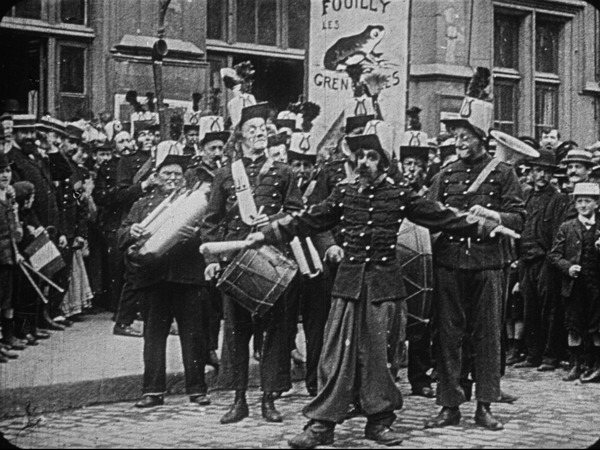NOT’ FANFARE CONCOURT
(Our Band’s Going to the Competition)
Albert Capellani (FR 1907)
The oldest title in the programme is a “musical”. Under the glorious emblem of the frog, the redoubtable “Fouilly les Grenouilles” brass band is setting off for a competition to be held in their subprefecture. The honour of the village is at stake; wives, cuirassiers, the mayor, and townspeople form an enthusiastic escort as the band makes its way to the station. Morale is high, the conductor is fired up, everything looks set for success. And a success it is. The band wins first prize – an enormous gold medal looking suspiciously like cardboard – and celebrates with a deceptively light wine, whose effects do not take long to make themselves felt. But, as the presentation in the Pathé catalogue informs us, “la belle médaille d’or a son revers” (“the beautiful gold medal has another side”), and the reception the wives give their drunken husbands when they come home isn’t exactly warm.
Although at least five years had passed since the film’s initial release (a long period at a time when cinema was undergoing whirlwind changes in style and language), it comes as no surprise that Pathé decided to include Not’ Fanfare concourt among the titles to relaunch in their 28mm home viewing format. In the popular genre of satirizing provincial simplicity – here stated in a decidedly good-natured, almost affectionate tone – the film sketches in a just few strokes a small fresco of amusing characters and situations: the mayor who refuses to relinquish the bourgeois dignity of the umbrella under his arm even on a totally sunny day, the proud triangle-player, the lanky flautist, or the wives ready to switch suddenly from caresses to delivering slaps in the face. Heading this company of well-made portraits is the band’s unrestrained conductor, identified by the Fondation Jérôme Seydoux-Pathé filmography as André Deed, here disguised with a moustache, a false nose, and hunchback, and representing a physical appearance clearly based on the tradition of circus clownerie; his bravura extends to an acrobatic turn when, carried away by the music, he falls off a wall and without missing a beat continues to direct his musicians.
Shot entirely in actual outdoor locations, the film also owes some of its expressive freshness to the extras recruited from the streets and effectively involved in the shooting. The enthusiastic fun being had by the youths and children watching the brass band perform and who follow its riotous foray along the street is a little show in itself.
We decided to adopt the attribution of the film’s direction to Albert Capellani given by the Seydoux-Pathé filmography, though some sources prefer to credit the less-renowned but prolific Henri Gambart. In any case, while the camera angles reveal an uncommon image composition (for example, the slightly off-centre framing of the entrance to the open-air café where the bandsmen celebrate their success), the mise-en-scène seems to be completely planned in advance for the camera and the infectious comic rhythm. You can almost hear the music.
Stella Dagna

regia/dir: Albert Capellani.
cast: André Deed?.
prod: Pathé Frères.
uscita/rel: 25.07.1907 (Omnia Pathé, Paris).
copia/copy: DCP, 5’13” (da/from 28mm, 68 m., 18 fps; 35mm orig. 195 m.); didascalie mancanti/intertitles missing.
fonte/source: Museo Nazionale del Cinema, Torino; Cinémathèque de Toulouse; Cinémathèque de Nouvelle-Aquitaine, Limoges.


 Italiano
Italiano